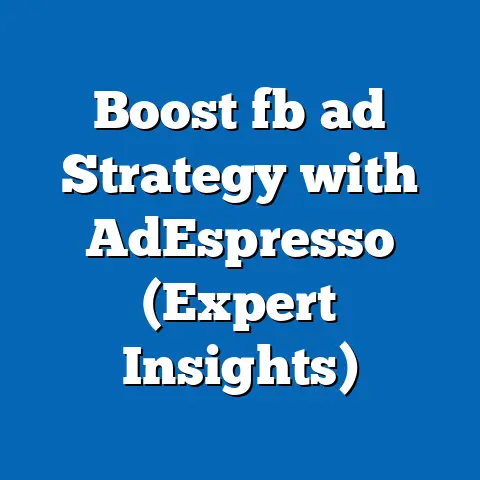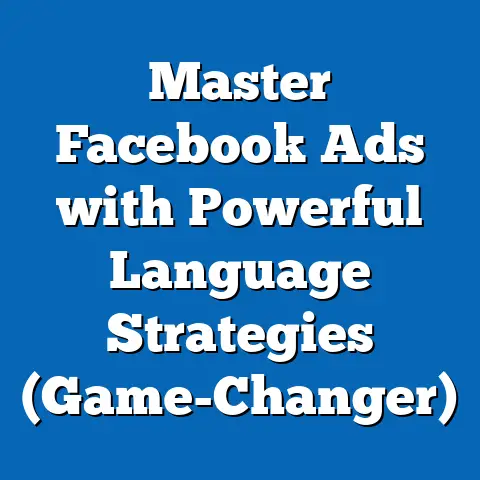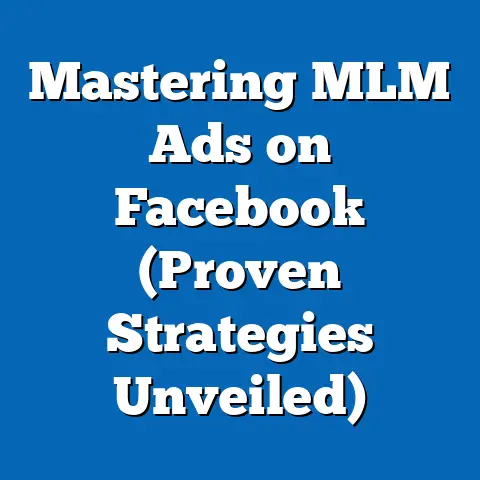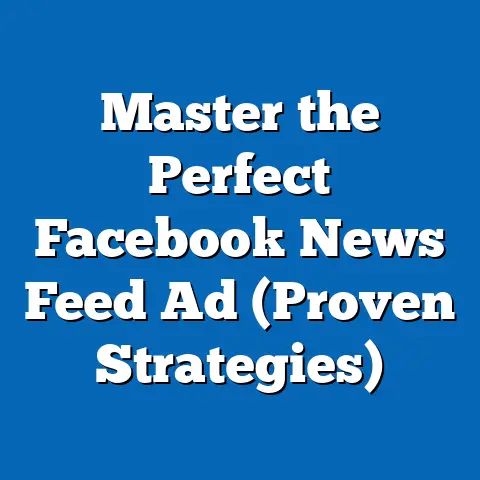Master Facebook Ads for Clothing Brands (Pro Strategies Unveiled)
The clothing industry is fiercely competitive. Standing out in a sea of brands, each vying for attention, requires more than just great designs. It demands strategic marketing, and in today’s digital landscape, Facebook Ads are an indispensable tool. With its massive user base and incredibly granular targeting options, Facebook offers clothing brands unparalleled opportunities to connect with potential customers. However, simply throwing money at ads isn’t enough. You need a strategic approach.
I’ve spent years helping businesses, including several clothing brands, navigate the complexities of Facebook advertising. I’ve seen firsthand what works and what doesn’t. My goal is to break down the often-intimidating world of Facebook Ads into simple, actionable steps that anyone can understand and implement. Forget the jargon and complex strategies – we’re going to focus on the core principles that drive results. This guide is designed to empower you, regardless of your experience level, to craft effective Facebook ad campaigns that boost your brand visibility and drive sales.
Understanding Your Audience
Before you even think about creating an ad, you need to know who you’re talking to. In the clothing niche, this is especially crucial. A t-shirt company targeting Gen Z will have a vastly different approach than a boutique selling high-end dresses to affluent women. Understanding your audience is the foundation of any successful marketing campaign, and Facebook Ads are no exception.
Creating Customer Personas:
The best way to understand your audience is to create detailed customer personas. These aren’t just vague descriptions; they’re fictional representations of your ideal customers, complete with names, backstories, interests, and motivations.
Here’s an example:
- Persona: “Streetwear Sam”
- Age: 22
- Occupation: College student, part-time barista
- Interests: Skateboarding, hip-hop music, streetwear fashion, sneakers, graphic design
- Shopping Habits: Regularly shops online, follows streetwear brands on Instagram, influenced by social media trends, price-conscious.
- Pain Points: Wants to stay on-trend without breaking the bank, struggles to find unique and affordable streetwear.
- Age: 22
- Occupation: College student, part-time barista
- Interests: Skateboarding, hip-hop music, streetwear fashion, sneakers, graphic design
- Shopping Habits: Regularly shops online, follows streetwear brands on Instagram, influenced by social media trends, price-conscious.
- Pain Points: Wants to stay on-trend without breaking the bank, struggles to find unique and affordable streetwear.
By creating personas like “Streetwear Sam,” you gain a deeper understanding of your target audience’s needs, desires, and behaviors. This allows you to tailor your ad messaging and targeting to resonate specifically with them.
Demographics, Interests, Behaviors, and Shopping Habits:
Facebook offers a wealth of targeting options based on these factors. You can target users based on:
- Demographics: Age, gender, location, education, income, relationship status.
- Interests: Hobbies, passions, activities they engage in online.
- Behaviors: Purchase history, device usage, travel habits.
- Shopping Habits: Online shopping frequency, preferred payment methods, engagement with specific types of ads.
Effective Audience Segmentation:
Different clothing brands require different segmentation strategies. Here are a few examples:
- Streetwear Brand: Target young adults (18-25) interested in skateboarding, hip-hop, and streetwear fashion. Use interests like “Supreme,” “Off-White,” and “Nike SB.”
- Luxury Brand: Target affluent individuals (35-55) with high incomes and interests in designer fashion, luxury travel, and fine dining. Use demographics like “High Net Worth” and interests like “Chanel,” “Gucci,” and “Luxury Lifestyle.”
- Activewear Brand: Target health-conscious individuals (25-45) interested in fitness, yoga, running, and healthy eating. Use interests like “Nike Training Club,” “Peloton,” and “Whole Foods Market.”
Key Takeaway: Knowing your audience is paramount. Create detailed customer personas and leverage Facebook’s targeting options to reach the right people with the right message.
Crafting Engaging Ad Content
You’ve identified your target audience, now it’s time to create ads that capture their attention. In the visually driven world of fashion, your ad content needs to be both aesthetically appealing and persuasive.
Elements of a Successful Facebook Ad:
- Headline: This is the first thing people see, so make it count. It should be concise, attention-grabbing, and relevant to your target audience.
- Image/Video: High-quality visuals are essential. Use professional-grade photos or videos that showcase your clothing in the best possible light.
- Ad Copy: This is your opportunity to tell a story, highlight the benefits of your clothing, and persuade people to take action.
- Call-to-Action (CTA): Tell people what you want them to do. Use clear and compelling CTAs like “Shop Now,” “Learn More,” or “Get 20% Off.”
Selecting High-Quality Visuals:
Your visuals should:
- Be Professionally Shot: Invest in professional photography or videography.
- Showcase Your Clothing: Highlight the details, fit, and quality of your clothing.
- Resonate with Your Brand Aesthetic: Maintain consistency with your brand’s visual identity.
- Appeal to Your Target Audience: Use models and settings that resonate with your target audience’s lifestyle and aspirations.
I once worked with a local boutique that was struggling to get traction with their Facebook ads. Their product photos were poorly lit and didn’t accurately represent the quality of their clothing. After investing in professional photography, their click-through rates and conversion rates skyrocketed. The difference was night and day.
Writing Concise, Compelling Ad Copy:
Your ad copy should:
- Be Concise: Get to the point quickly. People have short attention spans.
- Highlight Benefits: Focus on the benefits of your clothing, not just the features.
- Use Strong Verbs: Use action-oriented verbs that encourage people to click.
- Create a Sense of Urgency: Use phrases like “Limited Time Offer” or “While Supplies Last.”
- Match Your Brand Voice: Maintain consistency with your brand’s tone and personality.
Examples of Effective Ad Content:
Let’s analyze a few examples from successful clothing brands:
- Gymshark (Activewear): Their ads often feature fitness influencers wearing their clothing in dynamic workout settings. The copy focuses on performance and comfort, with CTAs like “Shop New Arrivals.” What makes them stand out is their use of authentic, relatable influencers and visually appealing video content.
- ASOS (Fast Fashion): Their ads showcase a wide variety of clothing styles, catering to diverse tastes. The copy is often playful and trendy, with CTAs like “Shop the Look.” They excel at using carousel ads to showcase multiple products and target different segments of their audience.
- Everlane (Sustainable Fashion): Their ads focus on transparency and ethical production practices. The copy highlights the quality and durability of their clothing, with CTAs like “Shop Our Latest Collection.” They differentiate themselves by emphasizing their commitment to sustainability and ethical sourcing.
Key Takeaway: Create visually stunning and persuasive ad content that resonates with your target audience and highlights the unique value proposition of your clothing brand.
Choosing the Right Ad Formats
Facebook offers a variety of ad formats, each with its own strengths and weaknesses. Choosing the right format for your marketing goals is crucial for maximizing your ROI.
Available Ad Formats:
- Image Ads: Simple and effective for showcasing a single product or brand message.
- Carousel Ads: Allow you to showcase multiple products or tell a story through a series of images or videos.
- Video Ads: Highly engaging and effective for capturing attention and conveying complex information.
- Collection Ads: Designed for mobile shopping, allowing users to browse and purchase products directly from the ad.
Suitability for Different Marketing Goals:
- Brand Awareness: Video ads and image ads are great for increasing brand visibility and recognition.
- Conversions: Carousel ads and collection ads are ideal for driving sales and product purchases.
- Product Launches: Video ads and carousel ads can be used to generate excitement and showcase new products.
Leveraging Ad Formats Effectively:
- Image Ads: Use high-quality photos that showcase your clothing in the best possible light. Keep the copy concise and focus on the key benefits.
- Carousel Ads: Showcase multiple products or tell a story through a series of images or videos. Use compelling headlines and descriptions for each card.
- Video Ads: Create engaging videos that capture attention and convey your brand message. Use strong visuals and a clear call-to-action.
- Collection Ads: Use high-quality product images and descriptions. Optimize your product catalog for mobile shopping.
I remember working with a client who was launching a new line of swimwear. We initially used image ads, but the results were underwhelming. After switching to carousel ads that showcased different angles and features of each swimsuit, their sales increased significantly. The carousel format allowed us to tell a more complete story and highlight the unique selling points of each product.
Key Takeaway: Experiment with different ad formats to find what works best for your clothing brand and marketing goals. Don’t be afraid to test new formats and strategies as Facebook continues to evolve its advertising platform.
Setting Up Targeted Campaigns
Creating compelling ad content is only half the battle. You also need to set up targeted campaigns that reach the right people at the right time.
Setting Up a Facebook Ads Campaign:
- Select Your Campaign Objective: Choose an objective that aligns with your marketing goals (e.g., brand awareness, traffic, conversions).
- Define Your Target Audience: Use Facebook’s targeting options to reach your ideal customers based on demographics, interests, behaviors, and shopping habits.
- Set Your Budget: Determine how much you’re willing to spend on your campaign. You can set a daily budget or a lifetime budget.
- Choose Your Ad Placements: Select where you want your ads to appear (e.g., Facebook News Feed, Instagram Feed, Audience Network).
- Create Your Ads: Design your ad content and write compelling copy.
- Track Your Results: Monitor your campaign performance and make adjustments as needed.
A/B Testing:
A/B testing is essential for optimizing your ad performance. It involves creating multiple versions of your ad with slight variations (e.g., different headlines, images, or CTAs) and testing them against each other to see which performs best.
I always recommend A/B testing to my clients. It’s the best way to identify what resonates with your target audience and improve your ad performance over time.
Budget Allocation Strategies:
- Start Small: Begin with a small budget and gradually increase it as you see positive results.
- Allocate Budget Based on Performance: Allocate more budget to campaigns and ads that are performing well.
- Test Different Budget Levels: Experiment with different budget levels to see how they impact your results.
Determining the Right Amount to Spend:
The right amount to spend on Facebook Ads depends on several factors, including your marketing goals, target audience size, and industry competition. There’s no one-size-fits-all answer.
Key Takeaway: Set up targeted campaigns that reach the right people with the right message. A/B test your ads to optimize performance and allocate your budget wisely.
Analyzing and Optimizing Performance
Your Facebook Ads journey doesn’t end once your campaigns are launched. You need to continuously monitor your performance and make adjustments as needed to maximize your ROI.
Key Performance Indicators (KPIs):
- Click-Through Rate (CTR): The percentage of people who see your ad and click on it.
- Conversion Rate: The percentage of people who click on your ad and complete a desired action (e.g., purchase a product, fill out a form).
- Return on Ad Spend (ROAS): The amount of revenue you generate for every dollar you spend on ads.
- Cost Per Acquisition (CPA): The cost of acquiring a new customer through your ad campaigns.
Using Facebook Analytics and Ads Manager:
Facebook Analytics and Ads Manager provide a wealth of data about your campaign performance. Use these tools to:
- Track Your KPIs: Monitor your CTR, conversion rate, ROAS, and CPA.
- Identify Trends: Look for patterns and trends in your data.
- Understand Your Audience: Learn more about your target audience’s demographics, interests, and behaviors.
- Optimize Your Campaigns: Make adjustments to your targeting, ad content, and budget based on your performance data.
Ongoing Optimization and Refinement:
- Continuously A/B Test Your Ads: Experiment with different headlines, images, and CTAs.
- Refine Your Targeting: Adjust your targeting based on your audience insights.
- Optimize Your Budget Allocation: Allocate more budget to campaigns and ads that are performing well.
- Stay Up-to-Date with Facebook’s Latest Features: Facebook is constantly evolving its advertising platform. Stay informed about the latest features and best practices.
I’ve seen countless businesses transform their Facebook advertising results by simply paying attention to their data and making data-driven decisions. It’s not about guesswork; it’s about understanding what works and doing more of it.
Key Takeaway: Continuously monitor your campaign performance, analyze your data, and make data-driven decisions to optimize your Facebook Ads and maximize your ROI.
Conclusion
Mastering Facebook Ads for clothing brands is not about complex tactics or secret formulas. It’s about understanding your audience, crafting engaging content, choosing the right ad formats, setting up targeted campaigns, and continuously analyzing and optimizing your performance. By focusing on these core principles and remembering the importance of simplicity, you can unlock the immense potential of Facebook advertising and drive significant growth for your clothing brand.
Remember, success in Facebook advertising is a journey, not a destination. It requires continuous learning, experimentation, and adaptation. So, take action on the strategies outlined in this guide, embrace the learning process, and watch your clothing brand thrive in the digital landscape.





